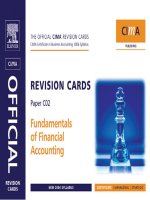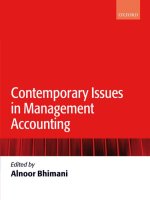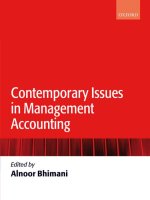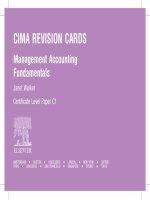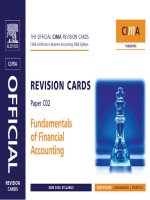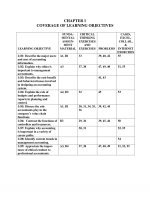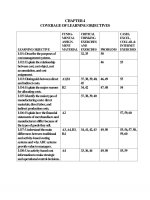Cima revision cards management accounting fundamentals by janet walker
Bạn đang xem bản rút gọn của tài liệu. Xem và tải ngay bản đầy đủ của tài liệu tại đây (643.79 KB, 122 trang )
CIMA REVISION CARDS
Management Accounting
Fundamentals
Janet Walker
Certificate Level Paper C1
AMSTERDAM l BOSTON
PARIS l SAN DIEGO l
HEIDELBERG
SAN FRANCISCO
l
l
l
LONDON l
SINGAPORE
l
NEW YORK
SYDNEY
l
l
OXFORD
TOKYO
Elsevier Butterworth-Heinemann
Linacre House, Jordan Hill, Oxford OX2 8DP
30, Corporate Drive, Burlington, MA 01803
First published 2005
Copyright ß 2005, Elsevier Ltd. All rights reserved
No part of this publication may be reproduced in any material form (including photocopying or storing in any medium by electronic means and
whether or not transiently or incidentally to some other use of this publication) without the written permission of the copyright holder, except in
accordance with the provisions of the Copyright, Designs and Patents Act 1988, or under the terms of a licence issued by the Copyright Licensing
Agency Ltd, 90 Tottenham Court Road, London, England W1T 4LP. Applications for the copyright holder’s written permission to reproduce any part
of this publication should be addressed to the publisher.
Permissions may be sought directly from Elsevier’s Science & Technology Rights Department in Oxford, UK: phone: (+44) 1865 843830, fax: (+44)
1865 853333, e-mail: You may also complete your request on-line via the Elsevier homepage
(), by selecting ‘Customer Support’ and then ‘Obtaining Permissions’
British Library Cataloguing in Publication Data
A catalogue record for this book is available from the British Library
Library of Congress Cataloging in Publication Data
A catalogue record for this book is available from the Library of Congress
ISBN 07506 64770
For information on all Elsevier Butterworth-Heinemann publications visit our website at
Printed and bound in Great Britain
Welcome to CIMA’s Official Revision Cards. These cards have been designed to:
.
.
.
.
.
Save you time by summarising the syllabus in a concise form
Jog your memory through the use of diagrams and bullet points
Follow the structure of the CIMA Official Study Systems
Refer to relevant questions found within the Preparing for the Assessment section of the study system
Provide you with plenty of assessment tips and hints
Ensure assessment success by revising with the only revision cards endorsed by CIMA.
TABLE OF CONTENTS
1.
2.
3.
4.
5.
6.
7.
8.
9.
10.
11.
Basic aspects of cost accounting ..................................................
1
Materials .............................................................................. 11
Labour ................................................................................. 19
Overhead .............................................................................. 25
Specific order costing ............................................................... 31
Continuous operation costing ....................................................... 37
Bookkeeping systems ............................................................... 55
Absorption costing and marginal costing.......................................... 63
Breakeven analysis and decision-making ......................................... 71
Budgetary planning and control .................................................... 87
Standard costing and variance analysis ........................................... 101
Basic Aspects of
Cost Accounting
The fundamental concepts of the framework of cost accounting
Topics
Key study system questions
1
3
Cost behaviour
High-low method
.
.
.
.
.
.
Cost units and cost centres
The classification of costs
The coding of costs
The elements of cost
Cost behaviour patterns
Analysing semi-variable costs
1
Basic Aspects of Cost Accounting
Cost units and cost centres
Definitions
The link between cost centres and
cost units
Þ
Cost centre – a production or service location,
function, activity or item of equipment for which
costs are accumulated
Þ
Cost unit – a unit of product or service in relation
to which costs are ascertained
Cost unit examples
Product: litre of paint, batch of cakes
Service: restaurant meal, tonne-mile
Cost centre examples
Location: production department A
Function: administration
A cost centre acts as a collecting place for costs.
The total cost centre cost may then be related to
the cost units which have passed through the cost
centre to determine a cost per unit
Activity: invoice processing
Item of equipment: stamping machine
2
——————————————————————————————————————————
––––––––––––––––––––––––––––––––––––––
Basic Aspects of Cost Accounting
The classification of costs
Costs are classified so that they can be arranged
into logical groups for further analysis
KK
K
K
Nature of cost: material, labour or expense
Direct or indirect
Functional analysis: production, selling,
distribution, administration
Fixed or variable
Controllable and non-controllable: important
when preparing management information
Normal and abnormal: highlighting abnormal
events draws them to managers’ attention
Relevant and non-relevant: in respect of
a particular decision
Þ
Þ
KKK
Types of cost classifications
Indirect costs are also referred to as
overheads
Semi-fixed, semi-variable or mixed costs
are partly fixed and partly variable
3
——————————————————————————————————————————
Basic Aspects of Cost Accounting
The coding of costs
KKK
Advantages of a coding system
A code is usually briefer than a description
Reduces ambiguity
Assists computerised processing of data
KK
KKK
Code – a system of symbols designed to be
applied to a classified set of items to give a brief
accurate reference, facilitating entry, collation and
analysis
Requirements for efficient coding
system
K
Definition
Each code should be unique and certain
Coding system should be comprehensive and
capable of expanding to include new items
Code numbers should be as brief as possible
Incorporate check digits in computerised codes
Only authorised personnel permitted to add new
codes to system
Code numbers should all be of the same length
4
——————————————————————————————————————————
––––––––––––––––––––––––––––––––––––––
Basic Aspects of Cost Accounting
The elements of cost
A sound understanding of the difference between
total direct cost, total production cost and total
cost will help you in assessment questions on a
variety of different topics
Direct materials
þ Direct labour
þ Direct expenses
¼ Total direct cost
þ Indirect materials
þ Indirect labour
þ Indirect expenses
¼ Total production cost
þ Other overhead
¼ Total cost
Remember this!
Direct costs are those that can be specifically
identified with a particular cost unit
Þ
Þ
Þ
Study tip
Total direct cost is also referred to as
prime cost
Indirect materials, indirect labour and indirect
expenses associated with production are
also referred to as production overhead
Other overhead includes selling,
distribution and administration overhead
5
——————————————————————————————————————————
Basic Aspects of Cost Accounting
Cost behaviour patterns
Cost behaviour patterns describe the way that costs behave in relation to changes in the level of activity.
Definition
Fixed cost – a cost which, within certain activity
limits, is not affected by fluctuations in the level of
activity
KK
Examples of fixed costs
Rent of the factory
Accountant’s salary
Definition
Stepped fixed cost – a cost which remains constant
for a range of activities, but which increases to the
next step when a critical level of activity is reached
KK
Examples of stepped fixed costs
Supervisors’ salaries
Machine rentals
6
——————————————————————————————————————————
––––––––––––––––––––––––––––––––––––––
Basic Aspects of Cost Accounting
Cost behaviour patterns
Definition
Variable cost – a cost which varies in relation to
the level of activity
KK
Examples of variable costs
Packaging material costs
Royalties
Definition
Semi-variable cost – a cost containing both
fixed and variable components and which is thus
partly affected by a change in the level of activity
KK
Examples of semi-variable costs
Telephone expenses
Gas and electricity bills
Semi-variable costs are also referred to as
semi-fixed or mixed costs
7
——————————————————————————————————————————
Basic Aspects of Cost Accounting
Example
Activity level
450 units
220 units
800 units
K
K
The high-low method
KK
Analysing semi-variable costs
Uses historical data on costs and activity levels
Selects the highest and lowest activity levels and
assumes that the change in cost between the
levels is caused by the change in variable cost
Variable cost per unit of activity is determined by
dividing change in total cost by change in activity
level
Fixed cost determined by substituting variable
cost per unit into either of the activity levels
Cost
£ 4,675
£ 4,330
£ 5,200
Analyse the cost into its fixed and variable components.
Solution
£ ð5;200 À 4;330Þ
ð800 À 220Þ
¼ £ 1:50
Fixed cost ¼ £ 5;200 À £ ð1:50 Â 800Þ
¼ £ 4;000
Variable cost per unit ¼
Study tip
This is a very important technique. It is vital
that you are able to apply it to a wide variety of
data. The activity measure will vary but the
technique remains the same
8
——————————————————————————————————————————
––––––––––––––––––––––––––––––––––––––
Basic Aspects of Cost Accounting
Analysing semi-variable costs
KKK
Scattergraph
Uses historical data on costs and activity levels
All available pairs of data plotted on graph
Line of best fit is drawn by eye
Example
Fixed cost ¼ vertical axis intercept ¼ £ 200
Variable cost per unit ¼ gradient of line of best fit
£ ð500 À 200Þ
¼
ð150 À 0Þ
¼ £ 2 per unit
Variable cost per unit is given by gradient
of line
Fixed cost is given by intercept on vertical
axis, i.e., cost at zero activity
Þ
Þ
9
——————————————————————————————————————————
Materials
Materials accounting and control procedures
Key study system questions
Topics
8
11
12
.
.
.
Stock level calculations
Stock control
Stock valuation methods
Recording stock movements
Stock control levels
Stock valuation
11
Materials
Recording stock movements
Ordering and receiving stock
Stockholding falls to reorder level
2
Storekeeper raises purchase requisition
3
Buying department completes purchase order
4
Goods received from supplier and goods
received note (GRN) completed
5
Supplier’s invoice received
Þ
Þ
Þ
Þ
Þ
1
Alternatively, a special order item might be
required
Details goods required. Copy sent to buying
department
Copy sent to supplier, to accounts
department and to storekeeper to confirm
goods are on order
Supplier may also leave a delivery note
Copy of GRN sent to accounts department
and to buying department
Invoice checked against purchase order
and GRN before being authorised for
payment
12
——————————————————————————————————————————
––––––––––––––––––––––––––––––––––––––––––––––––––
Materials
Recording stock movements
Issuing stock from stores
2
Excess materials returned to stores are
recorded on a materials returned note
3
Excess materials transferred to another job
without first returning to stores are recorded
on a materials transfer note
Details materials required and correct cost
centre, or cost, unit to be charged with use
of materials
Þ
Þ
Department requiring materials raises material
requisition
Þ
1
Ensures that cost of unused material is
credited to relevant cost centre, or cost unit,
and stock records are updated
Ensures that cost of material is charged to
correct cost centre or cost unit
13
——————————————————————————————————————————
Materials
Recording stock movements
K
K
This is known as a perpetual inventory
system
Þ
Bin cards and/or stores ledger cards record all
transactions and show continual record of stock
balance
Stock may be counted and checked against stock
records annually on a particular date
Alternatively, a number of items may be counted
and checked against records each day. This is
continuous stocktaking. Each item is checked
at least once a year
Þ
K
Recording and checking stock
balances
Continuous stocktaking cannot be carried
out unless a perpetual inventory system
exists
14
——————————————————————————————————————————
––––––––––––––––––––––––––––––––––––––––––––––––––
Materials
Stock control levels
Reorder level ¼ maximum usage  maximum lead time
Minimum level ¼ reorder level À (average
usage  average lead time)
Maximum level ¼ reorder level þ reorder
quantity À (minimum
usage  minimum lead time)
Average stock ¼ safety stock þ ½ reorder quantity
Study tip
You must memorize all the formulae on this card.
They will not be provided in the assessment
Þ
Þ
Þ
Þ
Stock kept at optimum level to minimise risk of
stock-outs and the costs of ordering and storing
stock. Usually achieved by monitoring free stock
balance ¼ physical stock þ stock on order with
suppliers À outstanding requirements unfulfilled
Reorder level ¼ level of free stock at
which an order should be placed for
replenishment stock
Minimum and maximum are warning
levels
Minimum stock often used as safety stock
in this formula
15
——————————————————————————————————————————
Materials
Stock control levels
Definition
EOQ ¼
As carrying costs increase the ordering costs
reduce
Þ
Economic order quantity – the order size which
minimises the sum of stock ordering costs and
stockholding
qffiffiffiffiffiffifficosts
2Co D
Ch
The EOQ formula will be provided in the
assessment if you need it. But make sure that you
know the meaning of each of the terms in the
formula
EOQ theory assumes average stock
¼ order quantity/2, i.e. no safety stock is held
Þ
Study tip
EOQ ¼ when total cost is
minimised ¼ point at which carrying cost is
equal to ordering cost
16
——————————————————————————————————————————
––––––––––––––––––––––––––––––––––––––––––––––––––
Materials
Stock valuation
K
K
K
Stock valuation methods
First In First Out (FIFO) – prices issues at the
price of the oldest items in stock
Last In First Out (LIFO) – prices issues at the
price of the latest items received into stock
Weighted average (AVCO) – prices issues at the
weighted average price of items in stock
Example data
Opening stock 1st March
Purchases 5th March
Issues 7th March
200 units at £ 2.00 per unit
500 units at £ 2.35 per unit
300 units
FIFO method
Value of issues 7th March ¼ (200 units  £ 2.00)
þ (100 units  £ 2.35)
¼ £ 635
Value of closing stock ¼ 400 units  £ 2.35 ¼ £ 940
LIFO method
Value of issues 7th March ¼ 300 units  £ 2.35 ¼ £ 705
Value of closing stock ¼ (200 units  £ 2.00)
þ (200 units  £ 2.35) ¼ £ 870
AVCO method
Average price ¼ ((200 Â £ 2.00) þ (500 Â £ 2.35))/700
¼ £ 2.25 per unit
Value of issues 7th March ¼ 300 units  £ 2.25 ¼ £ 675
Value of closing stock ¼ 400 units  £ 2.25 ¼ £ 900
17
——————————————————————————————————————————
Materials
Stock valuation
When prices are rising
Closing stock valuation
Charge to cost of sales
Reported profit
FIFO
Highest
Lowest
Highest
LIFO
Lowest
Highest
Lowest
AVCO
Between FIFO and LIFO
Between FIFO and LIFO
Between FIFO and LIFO
Calculating the weighted average price
Revised average price usually calculated
whenever new batch received into stock ¼
cumulative weighted average
If single average calculated at period end based
on total purchases for period ¼ periodic moving
average
18
——————————————————————————————————————————
Labour
Labour accounting and control procedures
Topics
Key study system questions
14
15
Labour remuneration
Labour remuneration
.
.
.
.
Remuneration systems
Labour turnover
Time and activity recording systems
Classification of labour costs
19
Labour
K
K
KK
KK
K
K
K
Employee paid for output
achieved: output
achieved  piecework rate per
unit
May include guaranteed
minimum wage
Differential system pays
increasing rates for higher
output: important to state if
higher rates apply to additional
units only
Important to check quality
Suitable where quantity of
output is important
K
Bonus schemes
Employee paid for hours
attended: hours attended
 agreed hourly rate
Wages not dependent on
output achieved
Overtime hours usually paid at
premium above basic rate
Suitable where: output difficult
to measure, activities
undertaken vary widely,
quality of output important
K
Piecework systems
K
Time-based systems
K
Remuneration systems
Employee paid a bonus for
time saved against agreed
target
Benefit of efficiency shared
between employee and
employer
Many different schemes
May be applied to groups
where: operations carried out
in groups, not possible to
measure individual
performance, whole group
must work faster to exceed
targets
20
——————————————————————————————————————————
––––––––––––––––––––––––––––––––––––––––––––––––––––
Labour
Labour turnover
Benefits
Labour turnover – a measure of the number of
leavers relative to the size of the workforce.
Usually expressed as a percentage
Labour turnover ¼
number of leavers replaced
average number of employees
 100%
May help to reduce turnover and encourage higher
morale among workforce. For example:
KKKKKK
Definition
company cars
staff discounts
subsidised canteen
health insurance
pension scheme
cre`che facilities
Study tip
Learn this formula. It will not be provided in the
exam
21
——————————————————————————————————————————
